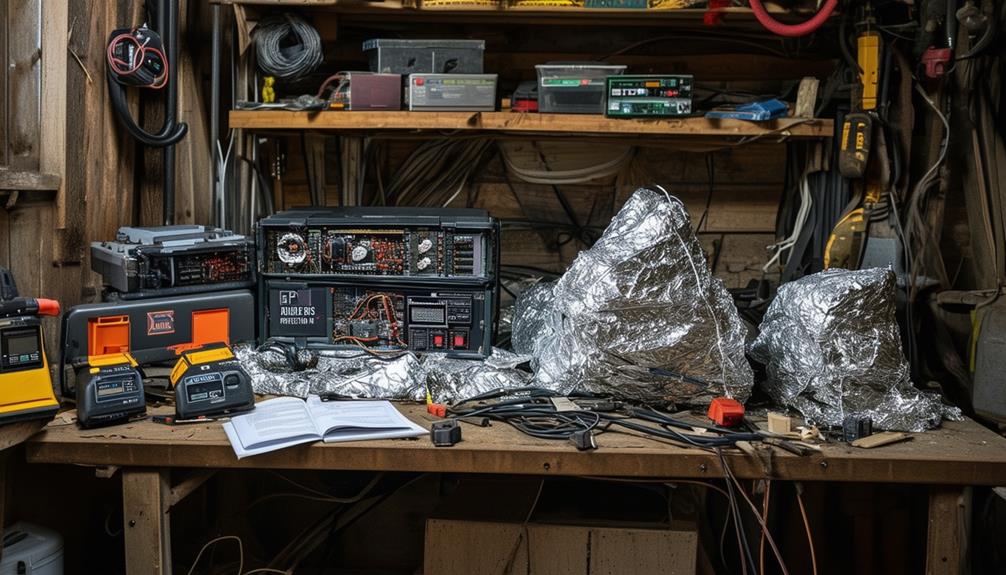Debunking Myths and Misconceptions About EMPs

You may have heard alarming stories about electromagnetic pulses (EMPs) wiping out all electronics and thrusting society back to a primitive state. But how much of that is actually true? It's essential to distinguish fact from fiction regarding EMPs.
While they can cause significant disruptions, the extent of their impact is often exaggerated. EMPs can be generated from both natural sources, such as solar flares, and man-made sources, like nuclear explosions. Understanding these basics helps clarify why the common narrative doesn't always match reality. So, what are the real risks, and how can you protect your electronics?
Understanding EMP Basics

An electromagnetic pulse (EMP) is a sudden burst of electromagnetic energy capable of disrupting or damaging electronic devices. Understanding EMP basics is crucial for recognizing how such pulses can impact everyday technology. The effects of an EMP can vary from temporary disruptions to permanent damage, depending on the pulse's strength and proximity to the affected devices.
EMPs can originate from various sources, including natural events like lightning and solar flares, as well as human-made incidents such as nuclear explosions. Although EMPs themselves aren't radioactive and don't pose direct harm to humans or animals, they can cause significant issues for electronics.
Metallic objects can exacerbate the effects of an EMP, resulting in damaging voltage surges. To protect your devices, consider using Faraday cages, which can shield electronics from EMP effects. Modern electronics are particularly vulnerable due to their densely packed, sensitive circuits.
Man-made and Natural EMPs
Both man-made and natural Electromagnetic Pulses (EMPs) can significantly disrupt electronic devices, but they originate from vastly different sources. Man-made EMPs, such as those resulting from nuclear detonations, are often associated with military applications and require substantial power and sophisticated equipment. High-Altitude Electromagnetic Pulse (HEMP) events, triggered by nuclear explosions in the upper atmosphere, pose severe risks to critical infrastructure and electronic systems.
In contrast, natural EMPs originate from phenomena like lightning and solar activity. These natural events can also be highly destructive, disrupting communication networks and damaging unprotected electronics. Metallic objects can act as antennas during such events, inducing voltage pulses that can damage devices with sensitive microelectronics.
Understanding the differences between man-made and natural EMPs is crucial for effective protection strategies. Contrary to the common misconception that only nuclear EMPs are dangerous, natural EMPs can also cause significant harm. Recognizing these distinctions helps in better preparing and safeguarding electronic equipment and critical infrastructure against potential threats.
Protecting Electronics

Protecting your electronics from electromagnetic pulses (EMPs) can often be achieved through straightforward yet highly effective methods. One of the simplest techniques is using metal containers to create a Faraday cage, which blocks the destructive voltage pulses from an EMP attack. This approach is practical and accessible for most households.
Measures to Safeguard Your Electronics
- Metal Containers: Store devices in metal containers or Faraday bags to shield them from EMPs.
- Grounding: Ensure your protection devices are properly grounded to divert harmful electrical surges.
- Backup Power: Use solar panels with High-altitude Electromagnetic Pulse (HEMP) protection to maintain power during an EMP event.
- Vehicle Protection: Use your car's metal body as a shield for small electronic devices.
- Surge Protectors: Invest in EMP-rated surge protectors for critical appliances and electronics.
Although circuit breakers are ineffective against fast EMP surges, these measures provide a robust line of defense. For those concerned about nuclear EMPs or other high-intensity electromagnetic pulse events, investing in these protective strategies can help safeguard your electronic devices and reduce disruptions to your power grid.
Public Perception Myths
Debunking myths about electromagnetic pulses (EMPs) is essential to clear up the exaggerated fears and misinformation often associated with this topic. Public perception myths about EMPs frequently overstate their effects, leading to unnecessary fear and confusion. You might've heard dramatic claims about EMPs wiping out all electronic devices or plunging entire nations into darkness indefinitely. These myths are often fueled by misinformation and fear-mongering.
Studies and reports indicate that while EMPs can indeed cause damage, the actual risks are often more contained and manageable than commonly portrayed. Understanding the facts about EMPs is crucial for accurately addressing public perception.
For example, not all EMPs have the same strength or impact. Many electronic systems have built-in protections and redundancies to mitigate EMP effects. Educating yourself and others about the real risks of EMPs is vital to dispel misconceptions. Clarifying these points helps combat the spread of misinformation and reduce unwarranted fear.
EMP Effects on Infrastructure

Electromagnetic pulses (EMPs) pose a significant threat to critical infrastructure, notably electric power grids and communication systems. An EMP event can lead to severe disruptions, with the electric power grids being particularly susceptible to damage, potentially resulting in extensive blackouts. This isn't just an inconvenience; it can halt essential services and disrupt daily life.
Critical infrastructure components, such as communication repeaters and generator controls, can suffer irreversible damage, leading to prolonged outages. Manufacturing plants, which depend on machine process controllers, may experience considerable production delays. Additionally, SCADA systems, responsible for remote pipeline pressure control, are vulnerable to failure from an EMP.
Key vulnerabilities include:
- Electric power grids: At high risk of damage, potentially causing widespread blackouts.
- Communication repeaters: Can experience permanent damage, leading to loss of functionality.
- Generator controls: Prone to operational failure due to EMP exposure.
- Manufacturing plants: Machine process controllers are at risk of failure, disrupting production.
- SCADA systems: Remote pipeline pressure controls can fail, impacting operations.
Recognizing these vulnerabilities is crucial for implementing protective measures to safeguard critical infrastructure against EMP effects. The first step in risk mitigation involves identifying the systems at risk and understanding their specific vulnerabilities.
Conclusion
Understanding that EMPs aren't the all-destroying forces some myths suggest can provide a clearer perspective. By grasping the differences between man-made and natural EMPs, you can better prepare and protect your electronics. Recognizing the true risks helps dispel public misconceptions and fosters informed decision-making. While infrastructure may be affected, it isn't typically as catastrophic as often portrayed. Staying informed empowers you to make smarter choices to safeguard against these electromagnetic disturbances.




